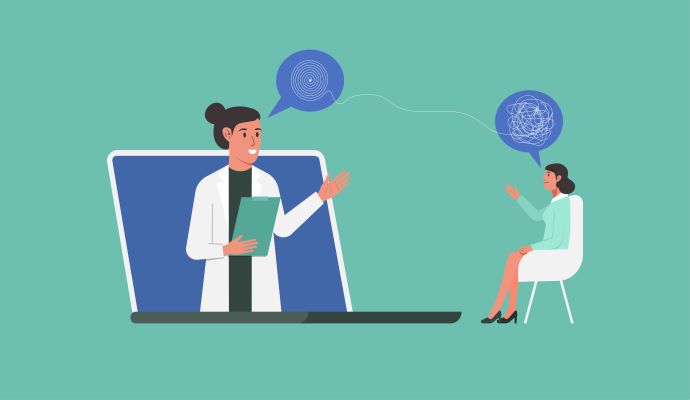Telemental Healthcare Use Varies Across Sociodemographic Lines
New research reveals that while outpatient mental healthcare visits have increased, telehealth use in this area varies based on social and economic factors.

Source: Getty Images
- Patterns in the use of audio-only or video-based telehealth to receive mental healthcare are mixed, differing based on age, sex, education, income, and location, according to new research by the Columbia University Mailman School of Public Health and Columbia University Irving Medical Center.
Published in the Annals of Internal Medicine, the study assessed trends in psychological distress and outpatient mental healthcare among United States adults between 2018 and 2021. The study also analyzed in-person, telephone-only, and video-based outpatient mental healthcare patterns.
Though America’s mental health epidemic has been ongoing for decades, the COVID-19 pandemic caused mental health issues to skyrocket. The rising prevalence of mental health conditions comes amid a decline in the availability of mental health professionals to address the crisis. Thus, healthcare provider organizations and other stakeholders are increasingly turning to digital health technology to close care gaps.
However, the Columbia University study shows that telehealth use for outpatient mental healthcare varies based on numerous sociodemographic factors.
For the study, the researchers analyzed data from the 2018–2021 Medical Expenditure Panel Surveys conducted by the Agency for Healthcare Research and Quality (AHRQ). The study sample included 22,227 respondents from the 2018 survey, 21,305 from the 2019 survey, 21,138 from the 2020 survey, and 21,988 from the 2021 survey.
Between 2018 and 2021, the rate of serious psychological distress among adults increased from 3.5 percent to 4.2 percent, researchers found. Additionally, there was an increase in the percentage of adults who reported less serious psychological distress and a decrease in those reporting no psychological distress.
Overall, the percentage of US adults reporting receiving outpatient mental healthcare increased from 11.2 percent to 12.4 percent. However, this rate decreased among adults with serious psychological distress from 46.5 percent to 40.4 percent.
Researchers chalked up the increase to greater telehealth use but noted that barriers persist.
Among the 12.5 percent of adults who received outpatient mental healthcare in 2021, 73.6 percent received care in person, 33.4 percent engaged in a video visit, and 21.4 percent participated in audio-only telehealth.
Receiving in-person, audio-only, or video-based mental healthcare varied across sociodemographic groups.
Adjusted percentages of video visits were higher for younger adults than for middle-aged or older adults, women than men, and college graduates than adults without a high school diploma. Further, higher-income, employed, privately insured, and urban US adults were more likely to engage in video visits than their respective counterparts.
On the other hand, audio-only care was more common among unemployed and publicly insured adults, though urban residents were still more likely to engage in phone-only care compared with rural residents.
A third of (33.7 percent) adults with serious psychological distress received in-person mental healthcare, while 12.4 percent received audio-only care, and 13.7 received video-based care. Among adults with less serious psychological distress, 13.9 received in-person care, 4 percent audio-only care, and 6.3 percent video-based telehealth.
“The national profile of adults who receive outpatient mental health care via telemental health – the younger adult, the employed, higher-income, and privately insured adults, raises concerns about disparities in access to virtual mental health care,” said study author Mark Olfson, MD, professor of epidemiology at Columbia Mailman School of Public Health, and the Dollard Professor of Psychiatry, Medicine & Law at Columbia University Irving Medical Center, in a press release. “Unless progress is made in reducing these barriers, primary care clinicians will continue to encounter challenges in connecting their older, unemployed, and lower-income patients to video-delivered outpatient mental health care.”
Mental healthcare has remained one of the clinical areas dominated by telehealth utilization.
Even as telehealth use dropped from 79 percent in 2020 to 74.4 percent in 2022, usage among psychiatrists and other mental health providers remained “well above that of physicians in other specialties,” according to an American Medical Association (AMA) survey analysis. The analysis released in December included data from the AMA’s Physician Practice Benchmark Surveys 2018-2022 and the 2022 quarterly Medicare Carrier Standard Analytic Files.
In 2022, more than 83 percent of psychiatrists said they provided a video visit the week before the survey, compared to 66.8 percent of primary care physicians, 64.3 percent of medical specialists, and 45.3 percent of surgeons.
Additionally, 54.1 percent of psychiatrists conducted more than 20 percent of their visits through videoconferencing in 2022.
